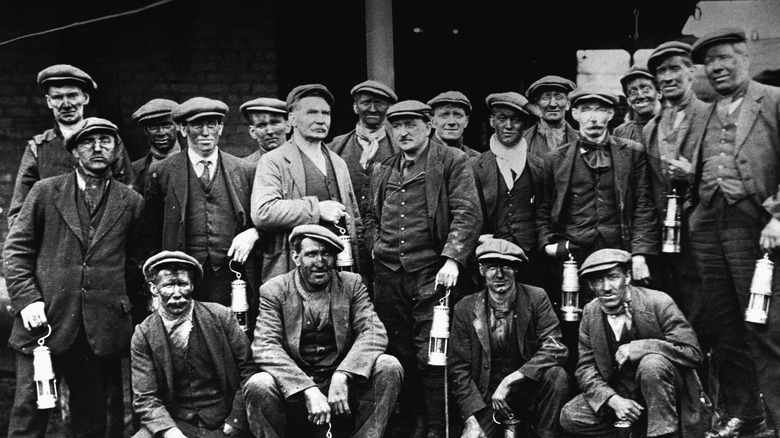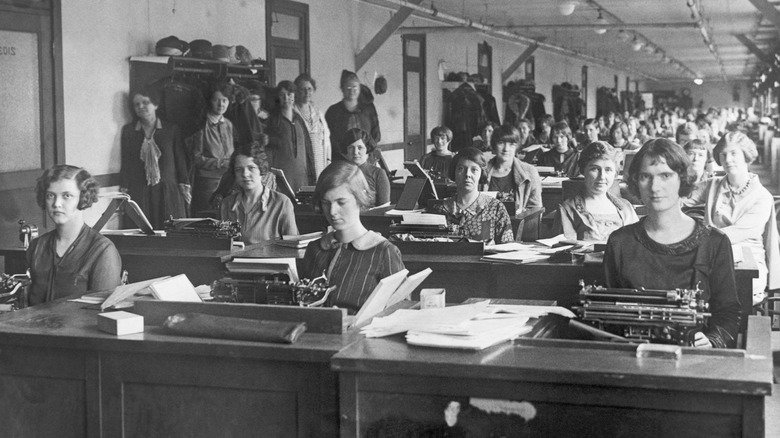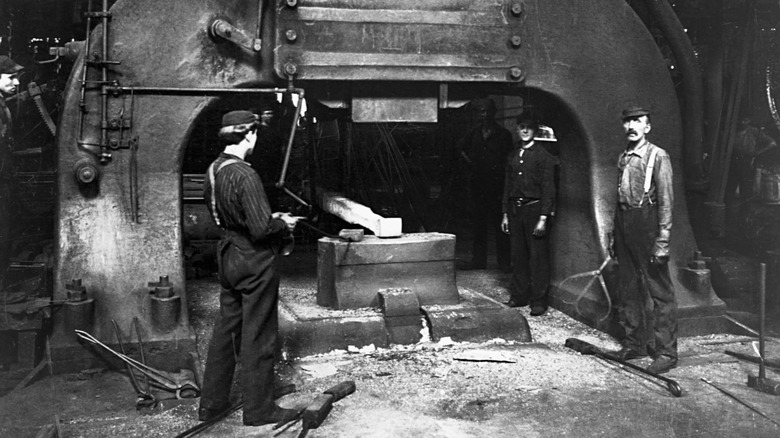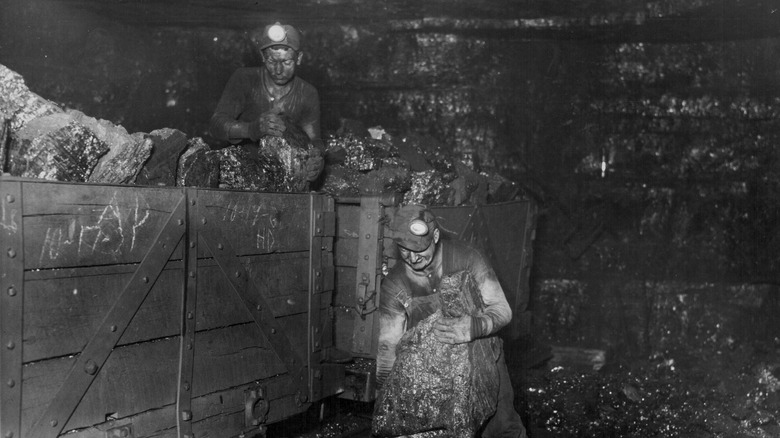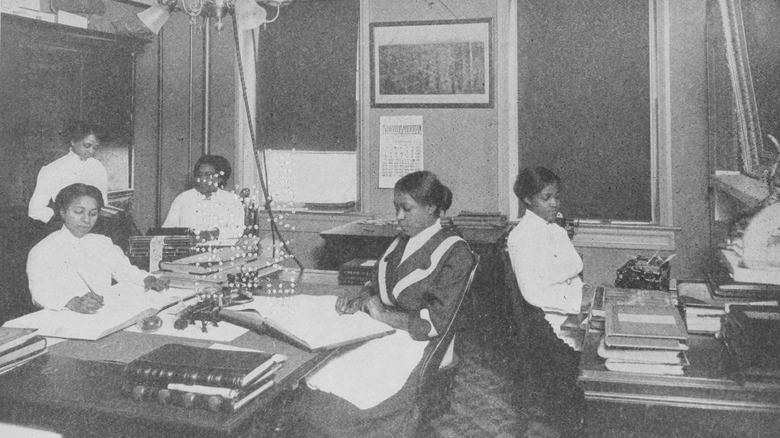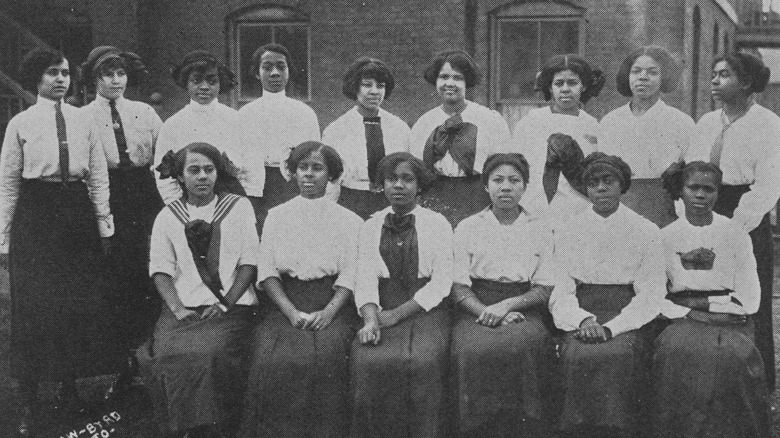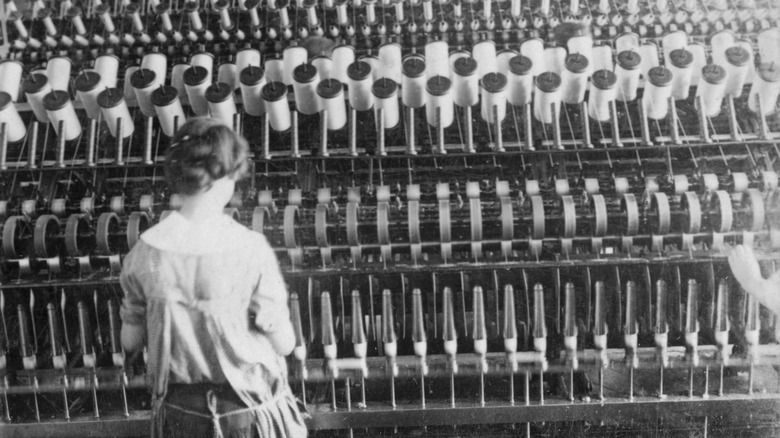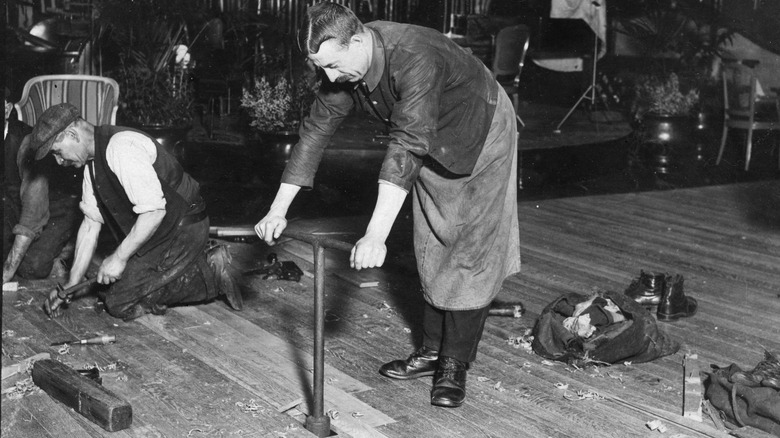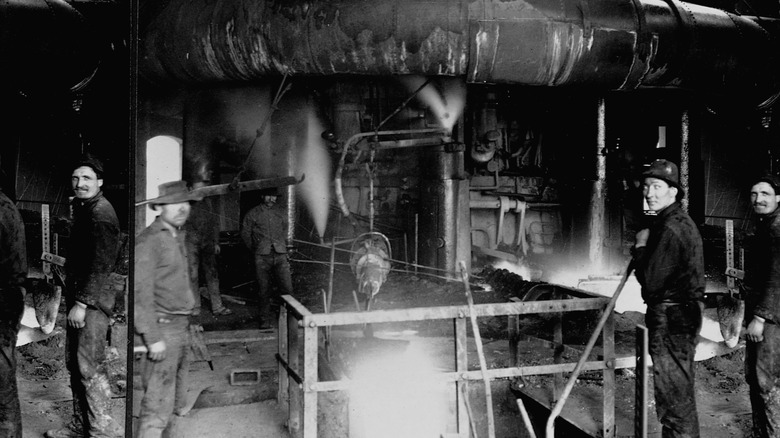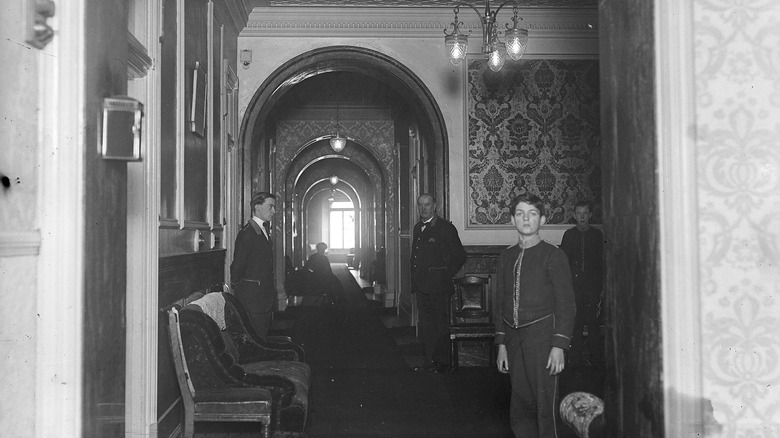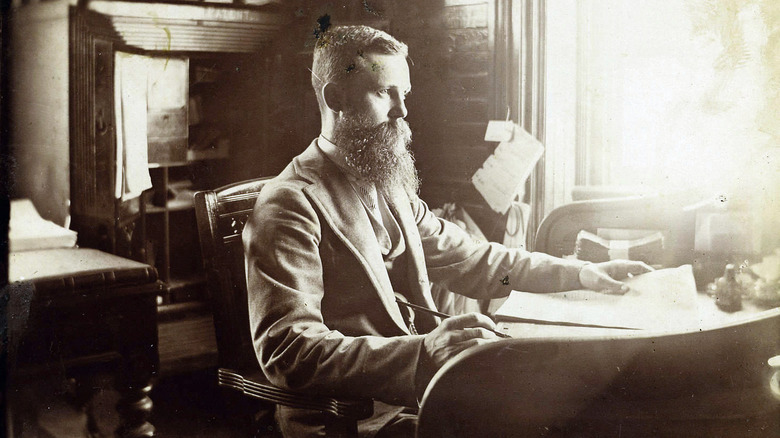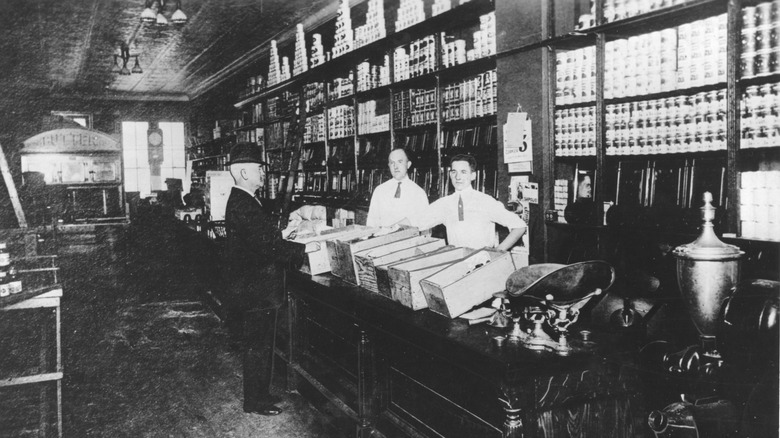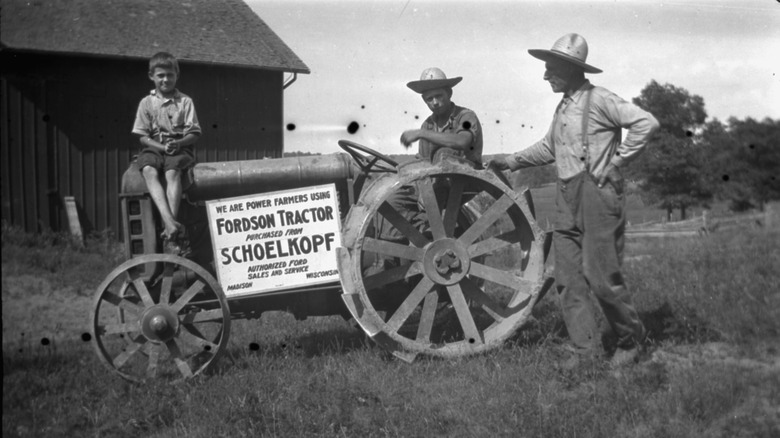The Most Popular Jobs 100 Years Ago
As society and technology advance, some jobs inevitably become obsolete, and over the past 100 years, the job market has seen a lot of changes; some industries have withered into shadows of their former selves, while others are brand new. With the invention of alarm clocks, no one needed someone to come by and tap on their window with a long stick. And as telephone technology matured, people were no longer required to connect calls from one person to another.
But despite these changes, some of the most popular jobs 100 years ago haven't changed much. Shopping was quite popular a century ago, warranting salespersons to facilitate the experience, and so it is today, with the most common job in the United States being a retail sales representative as of 2022, according to the U.S. Bureau of Labor Statistics.
It's not always easy to predict what jobs will remain and which will disappear as time passes. Sometimes automation leads to machines replacing the job, and other times, a societal shift does away with the position. Nonetheless, while few jobs have a consistently robust level of job security in the long term, some have still endured. These were the most popular jobs 100 years ago.
Stenographers and typists
Before stenographers and typists, people usually took notes and dictations from their employers by hand, a practice common in accounting and clerical work. But with the invention of the typewriter in the mid-19th century, the job evolved from laboriously writing down notes by hand to typing them up — a much faster method — with the larger businesses such as insurance and railroad companies making the transition in earnest. And in place of the men originally hired to take down dictations from their employers, the use of typewriters was coupled with hiring women to do the typing instead, not least because they could be hired at a lower rate of pay.
As women were increasingly able to enter the workforce in the early 20th century, one of their more popular job opportunities was being a stenographer or a typist. In 1920, over 610,000 people listed their job as stenographer or typist, and a majority were women, although children were also sometimes employed in these positions.
Curiously, because of this proliferation of women working as stenographers and typists, male stenographers started trying to distinguish between legal stenography and business stenography, claiming that courtroom stenography was more masculine, required physical and mental capabilities that women lacked, and could contain content that would be shocking to women, writes Janine Solberg in Literacy in Composition Studies. There was little chance of promotion from being a typist or a stenographer for the predominantly young women in these roles, as they were only expected to work for a brief time until they got married.
Steel industry workers
A century ago, one of the most common jobs in the United States was working in the steel and iron industries. According to the 1920 U.S. Census (via the United States Census Bureau), over 1.4 million people were employed by the steel and iron industries, and before modern safety standards, being a steelworker was very dangerous indeed. Not only were there no safety guards for the machines or protective clothing for the employees, it was also extremely hot, with the heat from the furnaces reaching over 3,000 degrees Fahrenheit.
The risks were high; hundreds were maimed or killed in steel plants every year by blast furnaces, electrocution, and falling objects. Steelworkers would pour molten steel into molds, and one worker reported, "If there was water in the molds when they would tap it, the damn thing would explode and metal would fly all over the area," per PBS. Many ended up partially deaf due to the immense noise at the steel factories. Immigrant workers for whom English was not their first language fared even worse: At places like the South Works steel plant, immigrant workers were injured at a rate twice that of English-speaking workers in the early 20th century, according to the U.S. Department of Labor.
As steelworking jobs were moved abroad or automated, the number of steelworkers in the United States fell drastically: According to IBISWorld, in 2023, only around 65,000 people were employed by iron and steel manufacturers.
Coal mine workers
At the beginning of the 20th century, coal was widely used across the United States as a source of energy and for manufacturing, with the majority being produced in Appalachia. This essential industry employed over 730,000 people around 1920, according to the 1920 U.S. Census (via the United States Census Bureau). Coal was in constant demand almost everywhere; steam engines, bakers, manufacturers, and domestic heating and cooking, to name just a few, and so coal miners were employed in massive numbers. In 1920s Appalachia, Black people initially made up over one-fourth of all coal mine workers, but not all by choice. Companies like Tennessee Coal, Iron & Railroad and United States Steel Corporation used convict labor — predominantly Black — to operate their coal mines.
Naturally, working in coal mines was dangerous, involving either going deep underground, or using a pickax or shovel to scrape the coal from the side of mountains. Over 1,500 people were killed on average every year in coal mining accidents, like roof collapses and gas explosions.
Demand for coal has since decreased, often in favor of more energy-efficient and greener energy alternatives. As a result of this lessened demand, and improvements in mining technology, the number of coal miners has declined drastically over the past 100 years, with only 55,000 people working in the coal mining industry in 2023, per IBISWorld.
Bookkeepers and accountants
Another popular job in the United States 100 years ago was the management of finances in the form of being a bookkeeper or an accountant. And unlike other industries, employment in this occupation has grown from a little under 750,000 workers in 1920 to over 1.7 million workers by 2020. Being a bookkeeper or an accountant initially involved doing data entry and calculations for one's employer. But as businesses and industries grew, they sought to attract investors and shareholders by showing their financial records, establishing the role of certified public accountants by the beginning of the 20th century.
Originally, the majority of workers in this occupation were men, with less than 800 women working as bookkeepers in the entire United States in 1870, per The Business History Review. But by 1930, there were over 465,000 women working as bookkeepers, comprising over 60% of the workers. However, while women started to dominate the world of bookkeeping, the field was split between bookkeepers and accountants — and accountants were mainly men. According to "Computer Chips and Paper Clips," although women were allowed to study to be accountants, they weren't always permitted to take a CPA exam to become certified. According to Accounting Historians Journal, by 1920, only around 11% of all accountants were women. But over the past 100 years, the demographics have continued to shift. As of 2023, over 61% of all accountants are women, per Zippia.
Teachers
At the beginning of the 20th century, up to half of the United States required some amount of mandatory school attendance. The majority of the states that required school attendance at either a public or private school were in the North, but by 1920, over 85% of children 17 and under were enrolled in school. And with so many students in public and private schools across the United States, there was a need for thousands of teachers, with over 760,000 people working as teachers in America in 1920. But there weren't enough teachers for all the students. In 1920, 25% of students had only a single teacher at their entire school.
Being a teacher initially involved teaching reading, writing, math, and history. By the 1920s, classes in cooking, sewing, and exercise started to be incorporated into curriculums.
Being a teacher was no easy job, as like today, resources for schools were gathered from their localities, but haphazardly so. Segregation amplified the disparity between the state of schools from different regions, resulting in some in the most impoverished rural areas only being able to provide a three-month-long school year. And compared to public school teachers nowadays, who make $65,000 annually on average, teachers in 1920 were making less than $2,000 annually, equivalent to roughly $30,000 today.
Textile industry workers
In the early 20th century, the textile industry employed a vast section of the public, with up to 790,000 people recorded as textile workers in the 1920 Census. Although the textile manufacturing industry started in New England, by the 1920s, the industry had begun to shift to Southern states. Multiple jobs were available in a textile factory, ranging from winding yarn onto bobbins, machine assistants, the laundry department, and managing machines.
Throughout the 1920s, textile workers faced various problems in the workplace, ranging from dangerous working conditions to health risks. And according to "North Carolina Women," edited by Michele Gillespie and Sally G. McMillen, one of the biggest issues in the industry was the fact that workers were made to work increasingly more for less pay. Known as the stretch-out, textile workers would have to operate twice as many machines while watching their weekly pay decrease.
The textile industry was also one of the few places where Black women could find employment, but they were typically given the lowest-paying positions. Children were frequently employed in textile factories, some as young as 10 years old, with up to a quarter of all workers being under the age of 16 in the early 20th century. The use of child labor within the textile industry wouldn't completely subside until the 1930s.
Carpenters
As long as wood is used as a building material, carpenters will always be in demand. And this is no less true now than it was 100 years ago, when over 885,000 people were employed as carpenters in the United States. But while wood and timber were popular building supplies throughout the 19th century, the use of timber started to wane by the 20th century. House frames stopped being made out of wood, and wood frames began to be mainly used for mills, bridges, and churches. With the rise of steelmaking, steel started to be used in building frames instead of wood balloon framings.
Wages for carpenters varied from $1 a day to $5. And compared to other jobs, carpenters have historically earned less in the United States. According to The Hustle, carpenters made 5% less than electricians in the 1920s, and this difference has only increased over the past 100 years to 14% less.
Machinists, millwrights, and toolmakers
With the rise of industrialization and factory work in the United States, workers were needed to set up and operate all the new machines being used. And by 1920, almost 900,000 people were working as machinists, millwrights, and toolmakers. As factory work continued to increase throughout the 20th century, machinists ended up enjoying more job security than other professions. In places like Philadelphia, Pennsylvania, machinists tended to have lower rates of unemployment between 1926 and 1935, according to "Ten Years of Work Experience of Philadelphia Machinists" by Helen Herrmann.
According to "The Reluctant Job Changer" by Gladys L. Palmer, Herbert S. Parnes, Richard C. Wilcock, Mary W. Herman, and Carol P. Brainerd, people went into working as toolmakers and machinists for various reasons, such as simply trying to make a living, or that they enjoyed working with machinery. But the amount of training involved wasn't often considered worth the low pay associated with the work — a common complaint of machinists and toolmakers. One worker remarked in 1924 that "there are many trades where one does not need to carry an expensive kit of tools and educate themselves to a list of figures and rules, and the compensation is easy double and sometimes triple those of our trade." Consequently, many people who worked as machinists or toolmakers often wanted to find another type of job.
Servants
While the nature of servant work has changed over the past century, it may surprise some to learn that more people are employed as servants or domestic workers now than 100 years ago. In 1920, over 1.2 million people were employed as servants and domestic workers, with jobs ranging from bellhops to nannies and cooks, and that number has almost doubled since then.
Domestic servants had various jobs and were often in charge of dusting, sweeping, laundry, cooking, dishes, silver polishing, and garden maintenance, among other things. But while in the 19th century most servants would live with their employers, by the 1920s, more people who worked as servants were working primarily during the day, rather than living with their employers and being on call at all hours of the day and night.
Because they were often kept out of working in factories in the 1920s, Black people were often employed as servants in places like homes, hotels, and railroads. Railroad companies like the Pullman Company's Palace Car had the highest rates of employment of Black people in the United States. These positions were typically incredibly exploitative with low pay, yet, by the end of the 1920s, over 500,000 Black people were working in domestic and professional service, and almost half of all Black women were employed as domestic servants. And in places like Atlanta, Georgia, up to 90% of Black women were employed in domestic service.
Clerks
As the number of offices and banks increased throughout the beginning of the 20th century, the number of people employed as clerks also grew. In 1920, almost 1.5 million people designated their job title as clerk in the U.S. Census. Initially, clerical work, like most other work, was limited to men. But by the beginning of the 20th century, more and more women were able to find employment as clerks. The duties of a clerk were diverse, including making sales, being responsible for deliveries, and even managing offices. Some of the work of clerks was later given to secretaries and typists, but before this, much of the work that involved writing duplicates of letters or copying accounts was done by clerks.
Although white women hired as clerks were initially derided in the mid-19th century, by 1920, being a clerk was the most popular employment possibility for white women, although wages were unstable and variable, falling and rising between 1914 and 1929. In Chicago, Illinois, out of roughly 200,000 clerks in 1920, half were women, including white women under the age of 24 and many from immigrant European families. And in New York City, many second-generation Italian and Jewish people worked as clerks. In Louisville, Kentucky, however, less than 1% of Black women were hired as clerks.
Retail dealers and salespersons
Retail transformed in the early 20th century with the rise of chain stores and department stores. And all those stores needed people to function, leading to one of the most popular employment opportunities in the United States. By 1920, over 3.1 million people worked in stores across America either as salespersons or retail dealers. The duties of a retail worker – opening and closing stores, restocking shelves, and assisting customers – have changed little over the past 100 years. But at the turn of the 20th century, retail workers also had to deal with incredibly difficult conditions, like being unable to sit all day long.
In department stores, salespersons often worked up to 15 hours every day without being allowed to sit. Conditions wouldn't improve until the Fair Labor Standards Act was passed in 1938. But despite these working conditions, many people sought jobs as salespersons and retail dealers due to the relative independence that the job offered. In Boston, Massachusetts, a retail training school was created, known as Prince's School of Salesmanship, which offered salesperson training. But this wasn't a job that was accessible to people of all income brackets, and was generally only given to middle-class women.
Door-to-door salespeople also became popular in the 1920s. The majority of companies only hired men, although some companies, like the California Perfume Company, also employed women as door-to-door salespersons.
Farmers
Despite the many popular jobs across the United States, nothing was more common 100 years ago than working on a farm, with over 10 million people counted in the 1920 Census as a farm worker, whether it be on a stock farm or a produce farm. The scale of American farming was so vast that up to 30% of people in America lived on a farm, with over 6.4 million farms of varying sizes across the country. But over the following century, the number of farmers in the United States dropped drastically to less than half its original amount.
Working on a farm in the 1920s was also an especially precarious time, with many farms suffering from thousands of dollars of mortgage debt. In Minnesota alone, over half of all farms had mortgage debt that totaled over $250 million, according to MNOPEDIA. During the 1920s, there were over 50,000 farm bankruptcies filed.
During this time, there were over one million Black farmers. But roughly 90% of the land owned by Black farmers was lost when white farmers purchased their debts. And despite the vast debts that white farmers accumulated during this time, The Nation writes that they in turn only lost 2% of their land.
